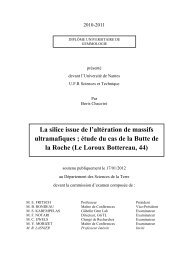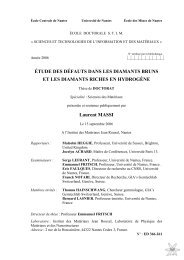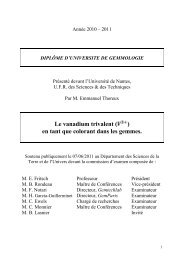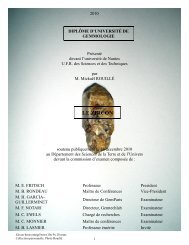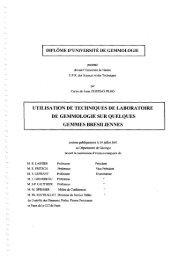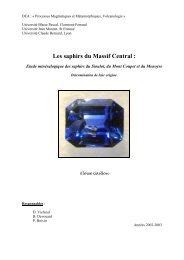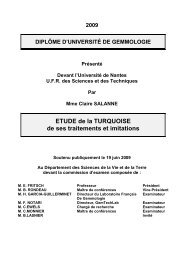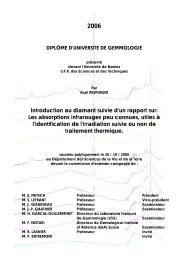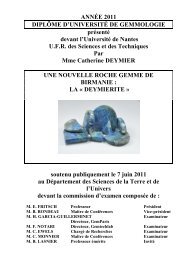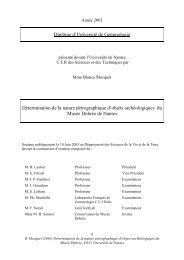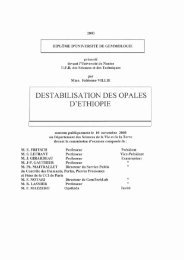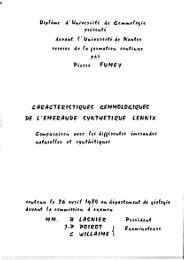Classification of brown diamonds and their color origin - GemNantes
Classification of brown diamonds and their color origin - GemNantes
Classification of brown diamonds and their color origin - GemNantes
Create successful ePaper yourself
Turn your PDF publications into a flip-book with our unique Google optimized e-Paper software.
light • medium light • medium • medium dark • dark • very dark<br />
Browns with strong modifying <strong>color</strong>s showing a saturated <strong>color</strong> are termed: deep<br />
“Deep” describes a medium dark to very dark <strong>color</strong> with strong saturation.<br />
The hue is described as follows: minor modifying <strong>color</strong>•major modifying<br />
<strong>color</strong>•minor dominant <strong>color</strong>•major dominant <strong>color</strong><br />
modifying <strong>color</strong>s are called: orangish, yellowish, olivish, pinkish, <strong>brown</strong>ish<br />
dominant <strong>color</strong>s are called: orange, yellow, olive, pink, <strong>brown</strong><br />
Olive is not a pure <strong>color</strong>, but a mix <strong>of</strong> <strong>brown</strong>, green <strong>and</strong> yellow. Nevertheles, “olive” is<br />
used as a <strong>color</strong> term in this work; some laboratories like GIAGTL use descriptions like<br />
“<strong>brown</strong>ish yellow green” for such <strong>diamonds</strong>. Here it was decided to use the term<br />
“olive”, since olive <strong>diamonds</strong> are a truly separate group <strong>and</strong> not even related to<br />
green <strong>and</strong> yellow green <strong>diamonds</strong>.<br />
Examples:<br />
-a dark <strong>brown</strong> diamond with a strong yellow component <strong>and</strong> a weak<br />
olive component will be called: deep olivish yellow-<strong>brown</strong>.<br />
-a medium <strong>brown</strong> diamond with a weak orange <strong>and</strong> a weak olive<br />
component (orange stronger than olive) will be called:<br />
medium olivish orangish <strong>brown</strong>.<br />
To avoid the influence <strong>of</strong> cut when it was tried to find relations between certain<br />
spectral features <strong>and</strong> the depth <strong>of</strong> <strong>color</strong>, the comparison <strong>of</strong> the depth <strong>of</strong> <strong>color</strong> was<br />
made with the <strong>diamonds</strong> table down; thus for this application the stones depth <strong>of</strong><br />
<strong>color</strong> was established through the pavilion (in the same manner as “<strong>color</strong>less”<br />
diamond <strong>color</strong>-grading).<br />
The <strong>color</strong> distribution was observed by immersion microscopy using methylene iodide<br />
<strong>and</strong> diffuse transmitted light. All photomicrographs were taken by the author with an<br />
Olympus Camedia 5050 digital camera with 5 megapixels <strong>and</strong> a special adaptor for<br />
the microscope (with magnifications <strong>of</strong> 30 to 420x).<br />
The 63 samples were then analyzed by advanced gemological testing.<br />
IR spectra in the range 7200 to 400 cm -1 were recorded with a PerkinElmer Spectrum<br />
BXII FTIR spectrometer equipped with a DTGS detector, using a beam condenser,<br />
with accumulation <strong>of</strong> 100 to 1000 scans at a resolution <strong>of</strong> 4 cm -1 to 2 cm -1 . For some<br />
stones, the sample chamber was flooded with gaseous nitrogen to reduce the CO2<br />
<strong>and</strong> H2O artefacts in the IR spectrum. Photoluminescence spectra were recorded<br />
with the <strong>diamonds</strong> cooled in liquid nitrogen (LN, -196°C [77K]) on an Adamas<br />
Advantage SAS2000 Raman spectrometer (resolution 1.5 nm) using a 532 nm<br />
semiconductor laser with integration times <strong>of</strong> 100 to 15’000 msec.<br />
VIS/NIR spectra <strong>of</strong> selected stones were analyzed with the Adamas Advantage<br />
SAS2000 VIS/NIR spectrometer (equipped with an integration sphere) in the range <strong>of</strong><br />
400-1000 nm at room temperature <strong>and</strong> at 77K, with a resolution <strong>of</strong> 1.5 nm <strong>and</strong> 100 to<br />
400 scans.<br />
The cathodoluminescence images <strong>of</strong> selected <strong>brown</strong> <strong>diamonds</strong> were observed <strong>and</strong><br />
recorded using a Jeol 5800 scanning electron microscope at the SEM facility <strong>of</strong> the<br />
IMN (Institut des Materiaux Jean Rouxel Nantes) at the University <strong>of</strong> Nantes, France.<br />
3. Results<br />
3.1. Visual Appearance<br />
The 63 samples covered nearly the whole range <strong>of</strong> <strong>color</strong>s, which are found in socalled<br />
<strong>brown</strong> <strong>diamonds</strong>. These include <strong>brown</strong>s modified by olive, pink, yellow <strong>and</strong><br />
orange plus a nearly “pure” olive <strong>color</strong>. The only <strong>color</strong>, which we were unable to find,<br />
is a <strong>brown</strong> with a modifying blue <strong>color</strong> (type IIb diamond).<br />
The observation <strong>of</strong> the minute <strong>color</strong> differences was difficult <strong>and</strong> all descriptions were<br />
made using reference stones. Especially in lightly <strong>color</strong>ed <strong>brown</strong> <strong>diamonds</strong> it is<br />
5



